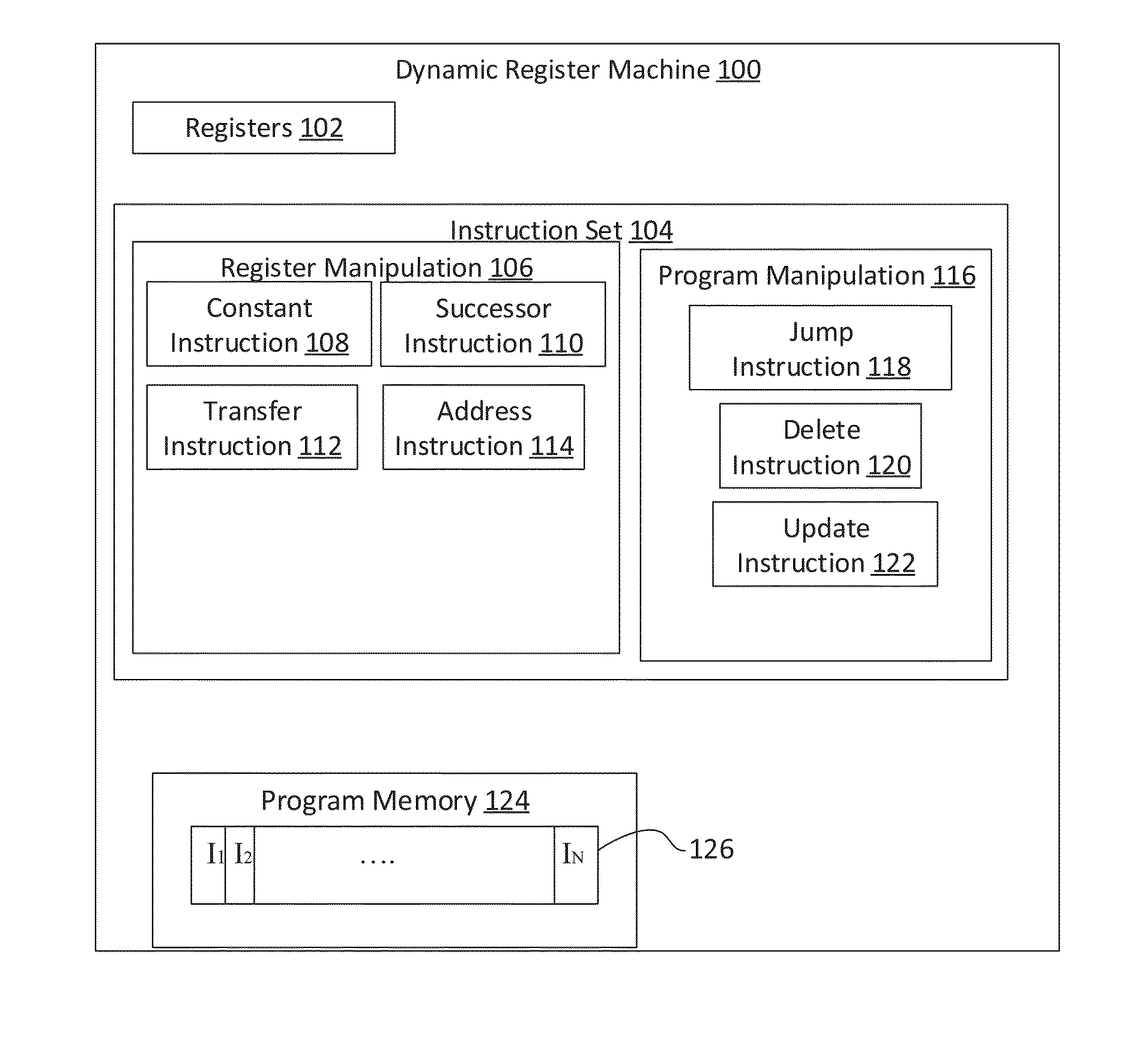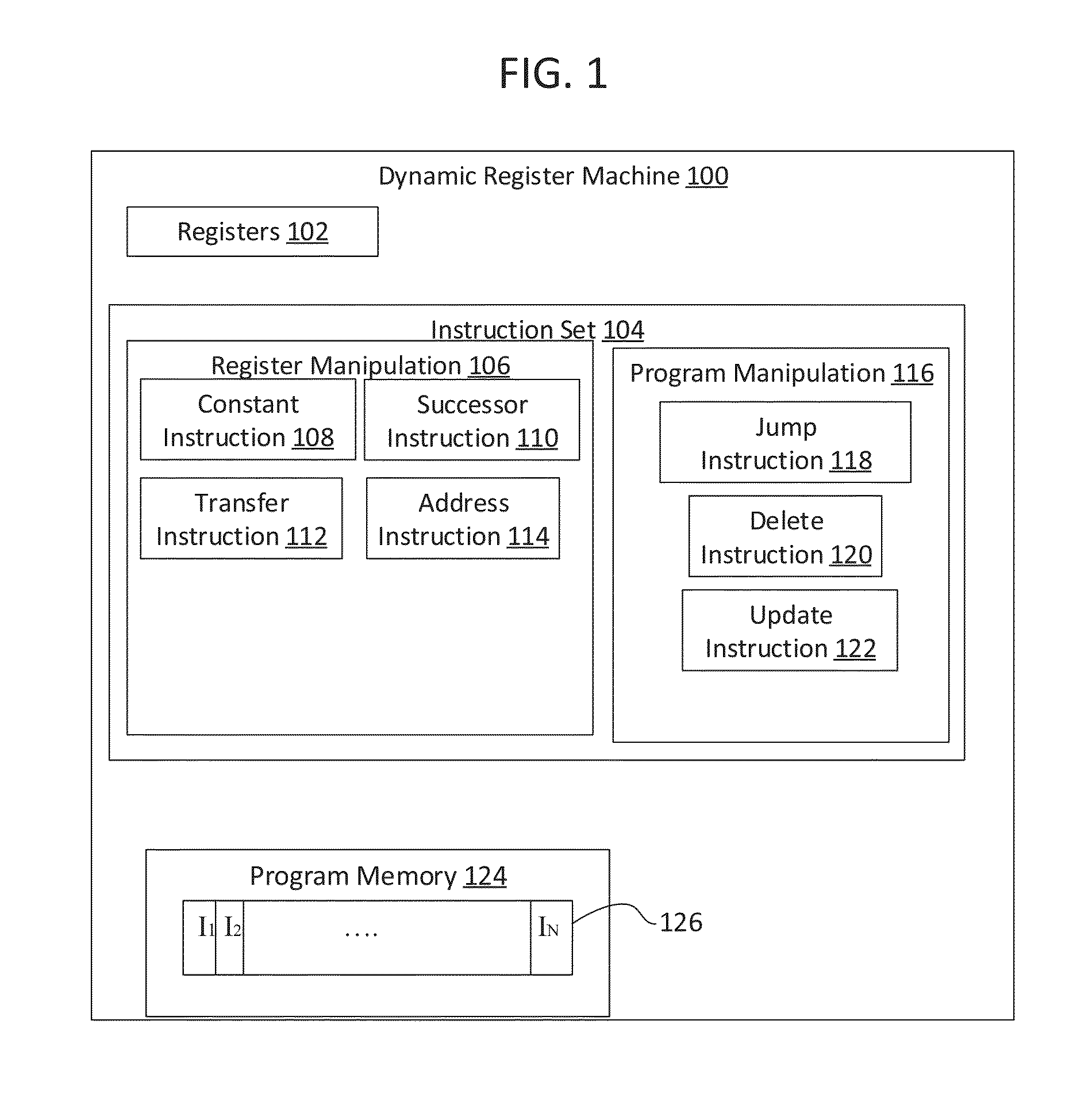Dynamic register machine
- Summary
- Abstract
- Description
- Claims
- Application Information
AI Technical Summary
Benefits of technology
Problems solved by technology
Method used
Image
Examples
example 3.3
[0179]
Q = {2, 3}. Halting state = 1 A = {1, 2}.Program 1034QTkη(q, Tk)21(1, 1, R)22(3, 2, L)31(2, 2, R)32(2, 1, R)3w22v2w12v3w12v2w22v3w22v
[0180]The immortal point is non-hyperbolic. Specifically, if the machine starts its execution at point p, then the minimal number of computational steps, denoted C(p), for the machine to return to point p is called the computational period of p. One can define the hyperbolic degree of an immortal point as m(p)=|R|−|L| and the periodic degree of the immortal point as C(p)=|R|+|L|, where if p is an immortal periodic point with computational period C(p), then C(p)=|R|+|L| where |R| denotes the number of right tape head moves during these C(p) computational steps and |L| denotes the number of left tape head moves during these C(p) computational steps (a more formal statement of the terms computational period and hyperbolic degree appear below after the introduction of some new notation and the discussion of some examples).
The tape head moves for this...
example
[0183]
Q = {2, 3, 4, 5, 6}. Halting state = 1. A = {1, 2}.Left pattern = 2 Middle Pattern = 1121. Right pattern = 1QTkη(q, Tk)21(3, 2, R)22(1, 2, R)31(4, 1, R)32(1, 2, R)41(1, 1, R)42(5, 1, R)51(6, 2, L)52(1, 2, R)61(2, 1, L)62(1, 2, R)2y112113y212114y212115y211116y211212y211213y221214y221215y221116y22112
[0184]The point p=[2, 21121 1] is the only immortal periodic point derived from state 2. The immortal point p has period C=5. The minimum left pattern “2” has length 1. The middle pattern “1121” has length 4; and the right pattern “1” has length 1.
EXAMPLE a machine having Q={q, r, s, t, u, v, w, x} and symbols A={1, 2} and halting state=h. left pattern=12, spanning middle pattern=121 2212, right pattern=212, and table
QTkη(q, Tk)Q1(r, 1, R)Q2(h, 2, R)R1(h, 1, R)R2(s, 2, R)S1(t, 1, R)S2(h, 2, R)T1(h, 1, R)T2(u, 2, R)U1(h, 1, R)U2(v, 1, R)V1(h, 1, R)V2(w, 2, R)W1(h, 1, R)W2(x, 1, L)X1(h, 1, R)X2(q, 2, R)
Below are the machine execution steps with tape head initially at tape square 1. Tap...
example 8.9
Directed Partition Examples
[0304]((0 8 2 3) (8 7 5 4) (5 0 6)) is an example of a directed partition.
[0305]((0 8 2 3) (8 7 5 4) (5 0 6)) is sometimes called a partition tuple.
[0306](0 8 2 3) is the first element tuple. And the first object in this element tuple is 0. Specifically, in the example of ((0 8 2 3) (8 7 5 4) (5 0 6)), each of the element tuples (0 8 2 3), (8 7 5 4), and (5 0 6) have sequence of numbers in which each number in the sequence only occurs once in that sequence in accordance with rule A. Also, in the example of ((0 8 2 3) (8 7 5 4) (5 0 6)), in accordance with rule B, the first object is 8, which is a member of the prior element tuple 0823, and the first object of the last element tuple, 506, is a 5, which is the third element of the prior element tuple, 8754.
[0307]Element tuple (8 0 5 7 0 3) violates Rule A because object 0 occurs twice. ((0 8 2 3) (1 7 5 4) (5 0 6)) violates Rule B since 1 is not a member of element tuple (0 8 2 3).
Consecutive Repeating Seque...
PUM
 Login to view more
Login to view more Abstract
Description
Claims
Application Information
 Login to view more
Login to view more - R&D Engineer
- R&D Manager
- IP Professional
- Industry Leading Data Capabilities
- Powerful AI technology
- Patent DNA Extraction
Browse by: Latest US Patents, China's latest patents, Technical Efficacy Thesaurus, Application Domain, Technology Topic.
© 2024 PatSnap. All rights reserved.Legal|Privacy policy|Modern Slavery Act Transparency Statement|Sitemap



